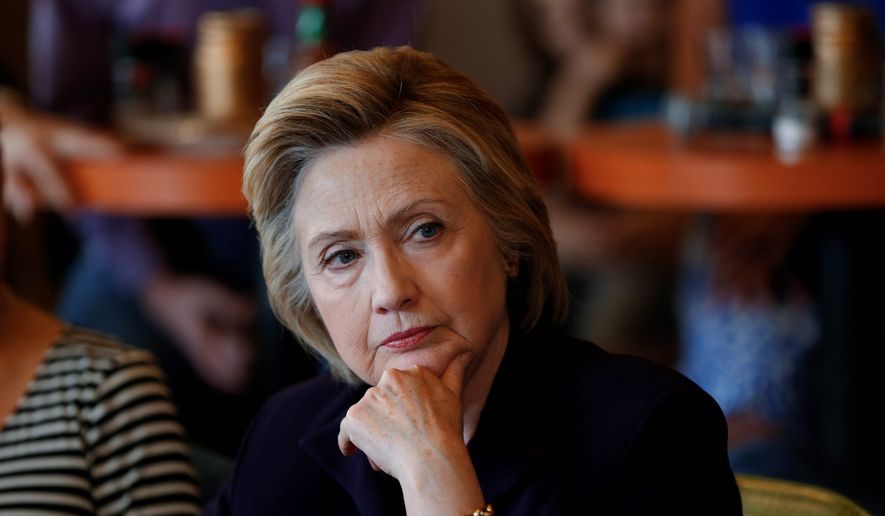Both of the Democratic Party’s presidential candidates seem to be looking past the Hoosier State’s Tuesday primary, with Sen. Bernard Sanders now focused on a strategy of wooing superdelegates to his side and Hillary Clinton making an all-out push in Appalachia to pull blue-collar, working-class voters into her camp.
Mr. Sanders rallied supporters during a campaign stop in Evansville, Indiana, on Monday, again blasting the “billionaire class” that he says is responsible for many of the ills affecting America today. But the Vermont senator’s campaign now seems more concerned with convincing Democratic superdelegates — party officials who are free to support either candidate — to switch allegiances and back him instead of Mrs. Clinton.
The shift in strategy is an admission of the electoral realities now facing his campaign. Mrs. Clinton is far ahead in the delegate race and is on track to win the Indiana contest Tuesday, polls show, meaning Mr. Sanders’ only shot at capturing the nomination will come at the party convention in Philadelphia.
“It is virtually impossible for Secretary Clinton to win all of the pledged delegates she needs to capture the nomination without the help of superdelegates at the convention,” Sanders campaign manager Jeff Weaver told supporters in a fundraising email Monday. “That means every vote we receive, every delegate we win between now and July strengthens our hand as we get to a contested convention.”
Mr. Weaver went on to cite polls showing Mr. Sanders performing better than Mrs. Clinton in hypothetical November match-ups with Republican presidential front-runner Donald Trump, using those figures as reasons why superdelegates should rethink their positions.
Winning over superdelegates is Mr. Sanders’ only real shot at winning the race. As of Monday, Mrs. Clinton has 2,165 delegates to just 1,357 for Mr. Sanders, according to an Associated Press tally. Among pledged delegates, she leads 1,645 to 1,318. Among superdelegates, she’s ahead 520 to 39.
It takes 2,383 to win the party nomination, and 92 delegates are at stake in Indiana on Tuesday.
Mrs. Clinton appears on track to win the state. The latest Real Clear Politics average of all polls shows her about 7 points ahead of Mr. Sanders.
Even if she lost the state, it wouldn’t change the overall trajectory of the race, and Mrs. Clinton is now looking beyond Indiana to the West Virginia primary on May 10 and the Kentucky contest on May 17.
The former secretary of state on Monday held two events in West Virginia and one in Kentucky, focusing on the decline in the manufacturing and coal-mining sectors and vowing to revitalize struggling rural economies if elected president.
“Talk about a ripple effect. It’s just devastating communities,” Mrs. Clinton said of the economic downturns facing towns across Appalachia, including Ashland, Kentucky, where she spoke Monday afternoon.
Winning over working-class voters will be crucial in Mrs. Clinton’s general election campaign, especially if the GOP nominates Donald Trump, who has struck a chord with blue-collar Americans in Appalachia and beyond.
On the campaign trail, Mrs. Clinton now is moving past Mr. Sanders and is training most of her fire on Mr. Trump. The billionaire real-estate mogul last week attributed Mrs. Clinton’s success to the fact that she’s a woman, and said he expects the former first lady to play the “woman’s card” as the general election campaign begins.
Political specialists say Mrs. Clinton is wise to capitalize on such attacks and should use them to motivate Democratic voters across the country who so far have been lukewarm to her candidacy.
“If Clinton is going to be able to reconstitute the Obama coalition, it will depend on firing up the base and that gets easier every time Trump makes such a blatantly incendiary attack like that,” said Stephanie A. Martin, a corporate communication and public affairs professor at Southern Methodist University who specializes in political rhetoric.
• Ben Wolfgang can be reached at bwolfgang@washingtontimes.com.




Please read our comment policy before commenting.